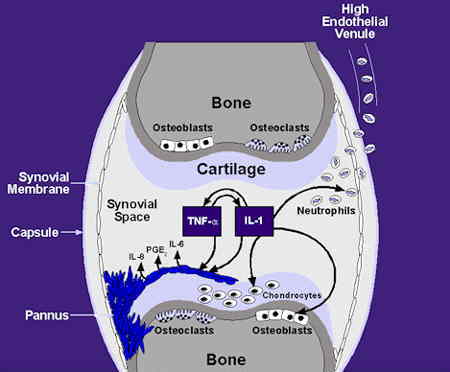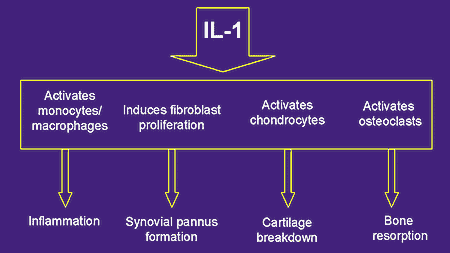IRAP therapy for Arthritis in Horses
by Robert N. Oglesby DVM
Introduction
Introduction
»
IL-1 and Osteoarthritis
»
IRAP Treatment Options
»
Viral Vectors
»
Autologous Conditioned Serum
»
IRAP Conclusions
»
More Info & Discussions
The first step to understanding what IRAP therapy is and it's role in the treatment of degenerative joint disease type of arthritis is to understand the acronym "IRAP". Let's explain the letters one at a time.
The "I" stands for Interleukin-1 (abbreviated IL-1) which is a cytokine, one of the first ever described. Cytokines are produced by cells and and then diffuse to another cell and alters the behavior of that cell. This means cytokines are a type of locally acting hormone. Interleukin-1 (IL-1) is believed to be a major mediator of joint disease by communicating with cells in the joint and inducing the release of inflammatory products. In order to exert it's effects IL-1 must communicate with cells by means of a receptor on the target cell it effects. This cell receptor to IL-1 is abbreviated as IL-1R and is the "R" in the acronym. If you can block the IL-1R you are antagonizing the receptor's activation, so "A"ntagonizing is the "A" in IRAP. A protein has been identified that antagonizes the IL-1R is referred to as a IL-1Ra Protein which become the P in IRAP. To put it all together without the abbreviations could look like this: Interleukin-1 Receptor Antagonizing Protein.
Inflammation can be a good thing but in degenerative joint disease the inflammation is excessive leading to further degeneration of the joint. IRAP therapy involves decreasing the effects of IL-1 with a protein. This article discusses IL-1 and it's role in DJD, the therapeutic options currently in use, and results of studies using this therapy in horses.
IL-1 and Osteoarthritis
Introduction
»
IL-1 and Osteoarthritis
»
IRAP Treatment Options
»
Viral Vectors
»
Autologous Conditioned Serum
»
IRAP Conclusions
»
More Info & Discussions
To summarize this somewhat technical explanation IL-1 is a key mediator of joint inflammation and is a pivotal cytokine that mediates and potentiates the inflammation, pain, and destruction of bone and cartilage in DJD.
In particular, IL-1 is a potent stimulator of synoviocytes, chondrocytes and osteoblasts. Cellular activation by IL-1 occurs through its binding to the membrane-bound IL-1 receptor. The IL-1/IL-1RI complex then forms a complex with the IL-1 receptor accessory protein (IL-1RAcP), leading to cell signalling and activation. IL-1 upregulates the production of prostaglandins and other proinflammatory mediators and thereby accounts for pain, swelling and tenderness typically seen in arthritic joints. This inflammation mediates the formation of pannus (synovial flaps high in inflammatory cells), destruction of bone, and cartilage in DJD, and also is believed to impair bone and cartilage repair.
IL-1-activated synoviocytes produce matrix metalloproteinases (MMP's) which cause proteoglycan degradation and in turn drives cartilage destruction. The MMP, stromelysin, appears to be pivotal in the activation of collagenase, an enzyme required for cartilage breakdown. The effect of IL-1 on chondrocytes is to inhibit proteoglycan synthesis and stimulate collagen breakdown preventing the normal maintenance of cartilage. In experimental models, this loss of cartilage proteoglycans has been shown to occur early in the disease process. Additionally, erosion of the cartilage surface is mediated by the formation of pannus and increased migration of polymorphonuclear cells into the synovial tissue; IL-1 has an important role in driving these processes. IL-1 also causes increased production of inducible nitric oxide synthase and consequently nitric oxide as part of the inflammatory process. High levels of nitric oxide kill chondrocytes, the cells responsible for cartilage remodeling.
IRAP Treatment Options
Introduction
»
IL-1 and Osteoarthritis
»
IRAP Treatment Options
»
Viral Vectors
»
Autologous Conditioned Serum
»
IRAP Conclusions
»
More Info & Discussions
You have just read the beginning of this article. To access the unabridged article
become a Member of Horseadvice.com! Your membership gets you instant access to this and over 600 articles on our site. Other benefits of your membership include participation in our discussion boards and access to our one button PubMed search tool for each topic.
Horseadvice can teach you to be a more knowledgeable horse owner which leads to a healthier horse and save you money. Really, we guarantee it.
Come Join Us!

